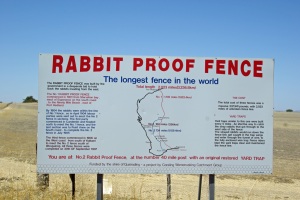Hoppy Easter, everyone! Hope you all had lots of good times with your family, fun egg hunts, and, of course, candy!
Of course, bunnies aren't always fun. Wait, what?
Australia has serious issues with invasive wildlife. Much of its ecosystem evolved in isolation from the rest of the world. So, when something prolific like a rabbit gets brought over by Europeans as a game animal on an island with plenty of resources, guess what happens?
Backing up a little, rabbits were brought to Australia by Europeans in the 1770's. In that day and age, colonists didn't particularly care that Australia had unique wildlife or indigenous people. They wanted to make everything in Australia as European as possible. That meant introducing rabbits as game animals.
Unfortunately, it is almost impossible to eradicate a population of rabbits. Some of the original 24 brought for hunting escaped and began running around Australia. With no real natural predators and plenty of grass, the rabbits did what they do best: Eat, spread, and, most importantly, get it on.
Let's put it this way: In an ecological system not used to dealing with mid-sized mammals that reproduce, well, like rabbits, bunnies wreak havoc. They attack plants - the base of the food web in many cases - leading many local species to go hungry. Predators often aren't equipped to handle bunnies, either. Those feet and teeth can seriously hurt. Yes, we're still talking about rabbits.
With no predators and plenty of food, the rabbits spread from Victoria to New South Wales and into the rest of Western Australia. People tried to build fences in the 1990's to keep the bunnies out, but they had already crossed the line. What started as 24 rabbits in the 1700's had ballooned to 10 billion in the 1920's.
The rabbits have been causing havoc in Australia ever since. They reduce native plant species by nibbling sprouts as soon as they bloom. They invaded the burrows of native species. There just aren't enough hunters to keep them at a stable level. Hell, bunnies are bacteria with spinal cords in terms of how versatile they are.
There have, of course, been attempts to stop the killer rabbits. The most successful of these has been a virus that specifically targets rabbits, causing them to develop mucus-filled lesions (myxomatosis). They die of hemorrhages and seizures within ten days. This virus, as with most things that target bacteria, eventually lost its effectiveness. Now the bunnies are on the rise again, ready to terrorize Australia with their cute, fluffy...yeah, it's hard to make rabbits sound intimidating. They're a big deal, OK?

So, when you open your chocolate rabbits (I know you have some left over), please think of Australia. Then go nuts biting that sugary rabbit's head off.
Of course, bunnies aren't always fun. Wait, what?
 |
| Like The Birds, only with fluffy bunnies. |
Australia has serious issues with invasive wildlife. Much of its ecosystem evolved in isolation from the rest of the world. So, when something prolific like a rabbit gets brought over by Europeans as a game animal on an island with plenty of resources, guess what happens?
Backing up a little, rabbits were brought to Australia by Europeans in the 1770's. In that day and age, colonists didn't particularly care that Australia had unique wildlife or indigenous people. They wanted to make everything in Australia as European as possible. That meant introducing rabbits as game animals.
Unfortunately, it is almost impossible to eradicate a population of rabbits. Some of the original 24 brought for hunting escaped and began running around Australia. With no real natural predators and plenty of grass, the rabbits did what they do best: Eat, spread, and, most importantly, get it on.
 |
| Disclaimer: Found on Photobucket. May or may not be in Australia. |
Let's put it this way: In an ecological system not used to dealing with mid-sized mammals that reproduce, well, like rabbits, bunnies wreak havoc. They attack plants - the base of the food web in many cases - leading many local species to go hungry. Predators often aren't equipped to handle bunnies, either. Those feet and teeth can seriously hurt. Yes, we're still talking about rabbits.
With no predators and plenty of food, the rabbits spread from Victoria to New South Wales and into the rest of Western Australia. People tried to build fences in the 1990's to keep the bunnies out, but they had already crossed the line. What started as 24 rabbits in the 1700's had ballooned to 10 billion in the 1920's.
 |
| Silly humans, rabbits can't read! |
The rabbits have been causing havoc in Australia ever since. They reduce native plant species by nibbling sprouts as soon as they bloom. They invaded the burrows of native species. There just aren't enough hunters to keep them at a stable level. Hell, bunnies are bacteria with spinal cords in terms of how versatile they are.
There have, of course, been attempts to stop the killer rabbits. The most successful of these has been a virus that specifically targets rabbits, causing them to develop mucus-filled lesions (myxomatosis). They die of hemorrhages and seizures within ten days. This virus, as with most things that target bacteria, eventually lost its effectiveness. Now the bunnies are on the rise again, ready to terrorize Australia with their cute, fluffy...yeah, it's hard to make rabbits sound intimidating. They're a big deal, OK?

So, when you open your chocolate rabbits (I know you have some left over), please think of Australia. Then go nuts biting that sugary rabbit's head off.



No comments:
Post a Comment